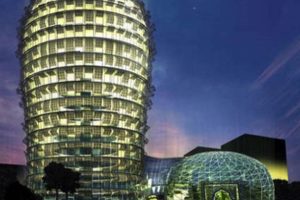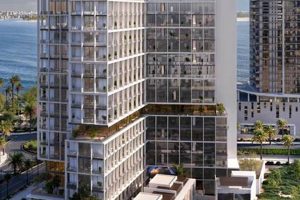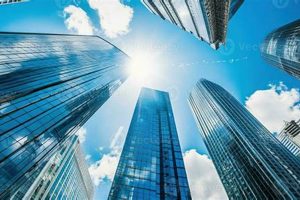A timber skyscraper is a high-rise building with a primary structure made from timber, a natural material derived from trees. These structures showcase advanced engineering techniques that enhance the strength and stability of timber, enabling the construction of buildings that soar to impressive heights.
Timber skyscrapers offer a range of benefits, including sustainability, reduced carbon footprint, improved air quality, and enhanced occupant well-being. As concerns about climate change intensify, timber skyscrapers emerge as a promising solution, offering a lower carbon alternative to traditional construction materials like steel and concrete. Timber sequesters carbon during its growth, and its use in construction can help mitigate the environmental impact of the built environment.
The history of timber skyscrapers dates back to the late 19th century, with the construction of early examples like the Tacoma Building in Chicago. However, advancements in timber engineering and fire safety regulations have spurred a renewed interest in timber skyscrapers in recent years, and several notable projects have been completed or are underway worldwide. These projects demonstrate the potential of timber as a viable and sustainable material for high-rise construction.
1. Sustainability
The sustainability of timber as a building material is a crucial aspect of timber skyscrapers. Timber is a renewable resource, meaning it can be replenished naturally, unlike non-renewable resources such as fossil fuels. Additionally, timber sequesters carbon dioxide during its growth, contributing to the reduction of greenhouse gases in the atmosphere. This carbon sequestration makes timber a carbon-negative material, further reducing the environmental impact of timber skyscrapers throughout their lifespan.
The use of timber in high-rise construction can significantly reduce the carbon footprint of buildings compared to traditional materials like steel and concrete. For instance, the Brock Commons Tallwood House, an 18-story timber skyscraper in Vancouver, Canada, has a carbon footprint that is 60% lower than a comparable concrete building.
Promoting the use of timber skyscrapers can contribute to mitigating climate change and creating a more sustainable built environment. As the world’s population continues to grow and cities expand, the demand for high-rise buildings will increase. By embracing timber as a sustainable alternative, we can reduce the environmental impact of urbanization and create more livable and sustainable cities.
2. Strength
The strength of timber is a crucial aspect that enables the construction of timber skyscrapers. Advanced engineering techniques have been developed to enhance the strength and stability of timber, allowing it to withstand the loads and forces encountered in high-rise buildings.
One such technique is cross-laminated timber (CLT), which involves gluing layers of timber together in a perpendicular orientation. CLT panels are incredibly strong and can be used to create load-bearing walls, floors, and roofs. Another technique is glulam, which involves bonding smaller timber sections together to form larger beams and columns. Glulam members are exceptionally strong and can be used to create long-span structures.
The strength of timber skyscrapers has been demonstrated in several real-life examples. The Brock Commons Tallwood House in Vancouver, Canada, is an 18-story timber skyscraper that uses CLT for its structural components. The building has proven to be highly resilient, withstanding high winds and seismic activity.
As timber skyscrapers continue to gain popularity, research and development efforts are ongoing to further enhance the strength and durability of timber construction. By pushing the boundaries of timber engineering, architects and engineers are creating innovative and sustainable high-rise buildings that meet the demands of modern society.
3. Fire safety
Fire safety is a critical aspect of timber skyscrapers, and advanced treatments have been developed to enhance the fire resistance of timber, meeting stringent safety regulations. These treatments involve impregnating timber with fire retardants or using fire-resistant coatings. The treated timber can resist ignition and slow down the spread of fire, providing valuable time for building occupants to evacuate and firefighters to respond.
The fire safety of timber skyscrapers has been demonstrated in real-life examples. The Brock Commons Tallwood House in Vancouver, Canada, is an 18-story timber skyscraper that uses fire-treated CLT for its structural components. The building has passed rigorous fire safety tests, showcasing the effectiveness of fire-resistant treatments for timber.
Understanding the connection between fire safety and timber skyscrapers is crucial for ensuring the safety of building occupants and firefighters. By incorporating fire-resistant treatments into timber construction, architects and engineers can design timber skyscrapers that meet or exceed fire safety codes and provide a safe environment for people to live, work, and visit.
4. Aesthetics
The natural beauty of timber brings a unique aesthetic appeal to timber skyscrapers, setting them apart from conventional high-rise buildings. Timber’s inherent warmth and texture create inviting and comfortable spaces, fostering a connection with nature within the urban environment.
- Organic Forms and Patterns
Timber’s organic nature allows for the creation of fluid and dynamic forms, breaking away from the rigid lines and sharp angles commonly associated with skyscrapers. Architects can incorporate curved elements, intricate patterns, and natural motifs into the design, resulting in visually striking and memorable buildings.
- Facade Versatility
Timber offers a wide range of facade options, allowing architects to express their creativity and adapt to different design contexts. Timber can be left exposed to showcase its natural beauty, stained or painted to achieve specific color schemes, or combined with other materials like glass and metal to create visually captivating exteriors.
- Interior Ambiance
Inside timber skyscrapers, the use of timber creates warm and inviting spaces. Timber’s natural ability to regulate humidity and acoustics contributes to occupant comfort and well-being. Exposed timber beams, columns, and walls bring a sense of warmth and character, fost
ering a connection between the building’s interior and exterior. - Landmark Potential
The unique aesthetic qualities of timber skyscrapers make them potential landmarks and iconic structures within the urban landscape. Their visually appealing designs and natural beauty can attract attention, generate a sense of place, and contribute to the overall identity and character of a city.
In conclusion, the aesthetics of timber skyscrapers encompass a harmonious blend of natural beauty and architectural innovation. Timber’s versatility allows for the creation of visually stunning and unique designs that enhance the urban environment, offering both functional and aesthetic benefits.
5. Cost-effectiveness
The cost-effectiveness of timber skyscrapers is a significant factor in their growing popularity. Timber can be a cost-competitive alternative to traditional construction materials, particularly when considering the long-term sustainability benefits. The use of timber in high-rise construction can lead to cost savings in several ways:
- Reduced Material Costs: Timber is a relatively abundant and renewable resource, which can result in lower material costs compared to other construction materials like steel or concrete.
- Faster Construction Times: Timber construction often involves prefabrication and modularization techniques, which can significantly reduce construction time and labor costs.
- Lower Maintenance Costs: Timber structures are naturally durable and require less maintenance compared to other materials, leading to long-term cost savings.
In addition to these direct cost savings, timber skyscrapers also offer long-term sustainability benefits that can indirectly contribute to cost-effectiveness. The use of timber sequesters carbon dioxide, reducing the building’s carbon footprint and potentially leading to lower energy costs. Timber buildings also tend to have better thermal insulation properties, resulting in reduced heating and cooling costs.
Real-life examples demonstrate the cost-effectiveness of timber skyscrapers. The Brock Commons Tallwood House in Vancouver, Canada, is an 18-story timber skyscraper that was constructed for a cost comparable to a conventional concrete building. The use of timber resulted in significant savings in material and labor costs, as well as reduced maintenance costs over the long term.
Understanding the cost-effectiveness of timber skyscrapers is crucial for developers, architects, and policymakers. By incorporating timber into high-rise construction, it is possible to achieve cost savings while promoting sustainability and reducing the environmental impact of the built environment.
6. Innovation
Innovation is at the core of timber skyscrapers, driving the development of groundbreaking architectural and engineering solutions that redefine the possibilities of high-rise construction. The use of timber as a primary structural material necessitates innovative approaches to design, engineering, and construction, leading to the creation of unique and sustainable buildings.
One of the key innovations in timber skyscrapers is the development of mass timber products, such as cross-laminated timber (CLT) and glulam. These engineered wood products possess exceptional strength and stability, enabling the construction of tall timber buildings that meet or exceed the structural requirements of traditional materials like steel and concrete. By pushing the boundaries of timber engineering, architects and engineers are able to create innovative structural systems that optimize material usage, reduce construction time, and enhance the overall performance of timber skyscrapers.
Another area of innovation is the integration of sustainable design principles into timber skyscrapers. Timber is a natural and renewable resource, and its use in construction can significantly reduce the environmental impact of high-rise buildings. By incorporating sustainable design strategies, such as passive solar design, natural ventilation, and rainwater harvesting, architects can create timber skyscrapers that minimize energy consumption, reduce water usage, and promote occupant well-being.
Real-life examples of innovative timber skyscrapers include the Brock Commons Tallwood House in Vancouver, Canada, and the Mjstrnet in Brumunddal, Norway. These buildings showcase the latest advancements in timber engineering and sustainable design, demonstrating the potential of timber as a viable and innovative material for high-rise construction.
Understanding the connection between innovation and timber skyscrapers is crucial for promoting sustainable and resilient urban development. By embracing innovation and pushing the boundaries of construction, architects and engineers can create timber skyscrapers that meet the challenges of the 21st century, including climate change, urbanization, and the need for sustainable building practices.
7. Urban integration
The integration of timber skyscrapers into urban environments offers several benefits that contribute to the creation of vibrant and sustainable cities. Timber skyscrapers can positively impact urban sustainability, neighborhood vitality, and overall quality of life.
One of the key benefits of timber skyscrapers in urban environments is their contribution to sustainability. Timber is a renewable resource, and its use in construction can reduce the carbon footprint of buildings. Timber skyscrapers also have good thermal insulation properties, which can lead to reduced energy consumption. Additionally, timber skyscrapers can be designed to incorporate green roofs and other sustainable features that further enhance their environmental performance.
Timber skyscrapers can also play a vital role in creating vibrant and livable neighborhoods. The use of timber in construction can create a warm and inviting atmosphere, making urban environments more pedestrian-friendly and attractive. Timber skyscrapers can also be integrated with green spaces and public amenities, creating inviting and inclusive public spaces that foster community interaction and well-being.
Real-life examples of timber skyscrapers that contribute to urban integration include the Brock Commons Tallwood House in Vancouver, Canada, and the Mjstrnet in Brumunddal, Norway. These buildings showcase how timber skyscrapers can be successfully integrated into urban environments, creating vibrant and sustainable neighborhoods that enhance the quality of life for residents and visitors alike.
Understanding the connection between urban integration and timber skyscrapers is crucial for promoting sustainable and livable urban development. By incorporating timber skyscrapers into urban planning and design, cities can reap the benefits of sustainability, neighborhood vitality, and overall quality of life.
Timber Skyscrapers
Timber skyscrapers, high-rise buildings with primary structures made from timber, are gaining attention for their sustainability, strength, and innovative designs. Here are answers to some frequently asked questions about timber skyscrapers:
Question 1: Are timber skyscrapers safe?
Yes, timber skyscrapers are safe. Advanced engineering techniques and fire-resistant treatments enhance the strength and fire resistance of timber, meeting stringent safety regulations. Real-life examples, such as the Brock Commons Tallwood House, demonstrate the safety and resilience of timber skyscrapers.
Question 2: Are timber skyscrapers sustainable?
Yes, timber skyscrapers are sustainable. Timber is a renewable resource that sequesters carbon dioxide during growth, reducing the environmental impact of construction. Timber skyscrapers also have good thermal insulation properties, leading to reduced energy consumption.
Question 3: Are timber skyscrapers cost-effective?
Timber skyscrapers can be cost-effective, especially considering their long-term sustainability benefits. Timber is a relatively abundant and renewable resource, which can result in lower material costs. Timber construction often involves prefabrication and modularization techniques, reducing construction time and labor costs.
Question 4: Are timber skyscrapers fire-resistant?
Yes, timber skyscrapers are fire-resistant. Timber can be treated with fire retardants or coated with fire-resistant materials to enhance its fire resistance. Real-life examples, such as the Mjstrnet, showcase the effectiveness of fire-resistant treatments for timber skyscrapers.
Question 5: Are timber skyscrapers durable?
Yes, timber skyscrapers are durable. Timber is a naturally durable material, and advanced engineering techniques further enhance its strength and stability. Timber skyscrapers are designed to withstand various loads and forces, including wind and seismic activity.
Question 6: Are timber skyscrapers aesthetically pleasing?
Yes, timber skyscrapers can be aesthetically pleasing. Timber’s natural beauty and versatility allow for visually appealing and unique designs. Architects can incorporate organic forms, intricate patterns, and natural motifs into the facade and interior, creating visually stunning and memorable buildings.
In summary, timber skyscrapers offer a sustainable, safe, and innovative approach to high-rise construction. Their environmental benefits, cost-effectiveness, fire resistance, durability, and aesthetic appeal make them a promising solution for sustainable urban development.
Transition to the next article section:
Explore the latest advancements and trends in timber skyscraper construction, including innovative engineering techniques and sustainable design strategies, in the following section.
Tips for Timber Skyscraper Construction
Timber skyscrapers offer a sustainable and innovative approach to high-rise construction. Here are five tips to consider for successful timber skyscraper construction:
Tip 1: Prioritize Sustainability
Incorporate sustainable design strategies into the project, such as passive solar design, natural ventilation, and rainwater harvesting. Utilize certified sustainable timber sources and consider the building’s lifecycle assessment to minimize environmental impact.
Tip 2: Ensure Structural Integrity
Collaborate with experienced structural engineers to design a robust structural system that meets or exceeds building codes and regulations. Use high-quality mass timber products, such as cross-laminated timber (CLT) and glulam, to achieve the necessary strength and stability.
Tip 3: Optimize Fire Safety
Implement comprehensive fire safety measures, including fire-resistant treatments for timber elements, advanced fire detection and suppression systems, and clear evacuation plans. Ensure compliance with relevant fire codes and regulations.
Tip 4: Focus on Cost-effectiveness
Explore innovative construction techniques, such as prefabrication and modularization, to reduce construction time and labor costs. Consider the long-term cost benefits of timber skyscrapers, including lower maintenance costs and potential carbon credits.
Tip 5: Enhance Aesthetics
Timber’s natural beauty and versatility offer unique design possibilities. Explore creative facade treatments, incorporate natural elements, and consider the building’s relationship to its surroundings to create visually appealing and iconic structures.
By following these tips, architects, engineers, and developers can harness the full potential of timber skyscrapers, contributing to sustainable and resilient urban environments.
Key Takeaways:
– Prioritize sustainability to minimize environmental impact.
– Ensure structural integrity for safety and durability.
– Optimize fire safety for occupant protection.
– Focus on cost-effectiveness for long-term benefits.
– Enhance aesthetics to create visually stunning buildings.
Transition to the article’s conclusion:
As timber skyscraper construction continues to evolve, these tips provide a valuable framework for achieving successful and sustainable high-rise buildings that meet the demands of the 21st century.
Conclusion
Timber skyscrapers have emerged as a transformative force in modern architecture, offering a sustainable and innovative solution to the challenges of urbanization. Their strength, durability, and aesthetic appeal, combined with their environmental benefits and cost-effectiveness, make them a promising choice for the construction of high-rise buildings in the 21st century.
As the world grapples with climate change and the need for more sustainable building practices, timber skyscrapers offer a compelling solution. Their ability to sequester carbon, reduce energy consumption, and promote occupant well-being positions them as a crucial element in creating sustainable and livable cities. The innovative use of mass timber products and advanced engineering techniques has pushed the boundaries of timber construction, enabling the realization of tall timber buildings that meet or exceed the performance of traditional materials like steel and concrete.
The future of timber skyscrapers looks bright, with ongoing research and development efforts promising even more sustainable and innovative designs. By embracing timber as a viable and sustainable alternative, architects, engineers, and urban planners can create vibrant and resilient urban environments that meet the needs of present and future generations.







